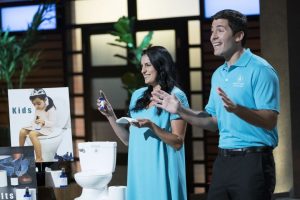Although water and wastewater treatment is a vital public service, often it is difficult for customers to understand the processes, products, and people that keep our water safe and our environment clean. Luckily, Hollywood has a way of bringing unseen and undiscussed concepts into the public eye through theaters and living rooms.
Last November, WEF Highlights described several movie and TV moments featuring the work and workplaces of water professionals – from the elite “Fatberg 5” clog-removal team featured in season 5 of the sitcom “Younger” to a haunted sewer-and-storm-drain network in horror flick IT (2017).
Now, the WEF Highlights editors have tracked down more on-screen moments where the worlds of film and water intersect.
Milorganite fertilizer – from Caddyshack (1980)
In a role that catapulted his comedy career, actor Bill Murray plays Carl Spackler, the erratic groundskeeper at the Bushwood Country Club in Caddyshack (1980). While most viewers likely remember Murray’s feud with a particularly destructive gopher, water professionals may recognize a subtle detail in Spackler’s shed at the 1:14:11 mark.
Spackler’s shed contains everything a gopher-obsessed country club landscaper could need: gardening tools, a fire extinguisher, a 6-pack of beer, and a lot of fertilizer. Milorganite fertilizer, to be exact. “So, I’ve got that going for me.”
The Milwaukee (Wis.) Metropolitan Sewerage District has produced and sold Milorganite fertilizer since 1926. Made from heat-dried microbes that have digested organic matter in municipal wastewater, Milorganite is one of the earliest and best-known examples of how water resource recovery can be lucrative for those facilities with the infrastructure to implement it.
https://www.youtube.com/watch?v=iR0sWU1HzTE
Caddyshack is available to watch on Netflix with a subscription.
R. C. Harris Water Treatment Plant – from various films and TV series
Known locally as the “Palace of Purification” for its opulent – and imposing – art-deco architecture, the R. C. Harris Water Treatment Plant in Toronto, Canada, often doubles as a prison, mental hospital, and supervillain lair.

Nicknamed “the Palace of Purification” for its imposing architecture, Toronto’s R. C. Harris Water Treatment Plant has been featured in at least 14 different movies and television series. It is most often used as a set for prisons and mental asylums. Public domain photo.
In the stoner comedy, Half Baked (1998), the facility appeared as a prison. Kenny Davis, played by actor Harland Williams, ends up behind bars at R. C. Harris after accidentally killing a diabetic police horse. His friends, a motley crew led by Dave Chappelle’s Thurgood Jenkins, must then raise $1 million to bail Kenny out.
In “RoboCop: The Series,” a 1994 television adaptation of the popular movie franchise, R. C. Harris became The Henry Ford Centre for the Criminally Insane. Appearing in several episodes during the show’s year-long run, the treatment facility became the home of such colorfully named villains as William Ray “Pudface” Morgan, Dr. Cray Z. Mollardo, and Vlad “Stitch” Molotov.
To date, the R. C. Harris Plant has appeared on screen in at least 14 different works, all while continuing to provide about 30% of Toronto’s drinking water, according to a city fact sheet.
Water reuse facility of the future – from The Matrix: Reloaded (2003)
Even in a dystopian future where humans lost the war against self-aware robots, everyone needs water. With humans forced to seek refuge underground, reusing water to promote sustainability is a priority, according to The Matrix trilogy.
In The Matrix: Reloaded (2003), the second installment in the popular sci-fi franchise starring Keanu Reeves, viewers can spot a split-second image of how water resource recovery facilities might one day look. At the 44:53 mark, Councilor Hamann (played by Anthony Zerbe) points out a piece of equipment in the last remaining human settlement. He comments on the power of technology to both help and harm. The enormous facility does not appear to require human operation and seems to function mainly via gravity, featuring a series of stacked reservoirs. However, even the Councilor admits that the exact treatment process is unclear.
“See that machine? It has something to do with recycling our water supply,” Hamann says. “I have absolutely no idea how it works.”
The Matrix: Reloaded is available to watch on Netflix with a subscription.
Pristine Cleaning Sprays and Grease Bags – from ABC’s “Shark Tank”
Disposing of fats, oils, and grease (FOG) and wipes improperly labeled “flushable” are two problems that can lead to massive collections system blockages and costly repair work. On ABC’s entrepreneurial reality show, “Shark Tank,” two businesses have won investments for proper waste-disposal solutions.

ABC’s “Shark Tank” has featured two products that directly relate to protecting collections systems, raising awareness of a costly problem with blockages from fats, oils, grease, and non-flushable wipes that affects cities around the globe. Photo courtesy of ABC.
In Season 8, Episode 13, single mom LaTangela Newsome introduced Grease Bags. 100% compostable and able to hold up to 907 g (32 oz) of oil, Newsome’s Grease Bags contain an ingredient used in oil-spill remediation that absorbs used oil into a pad. Newsome sought $75,000 for a 25% stake in her company. Real estate mogul Barbara Corcoran countered with $75,000 for 50% of the company; Newsome accepted.
In Season 10, Episode 10, cousins Jessica Karam Oley and Brandon Karam asked for $50,000 in exchange for a 20% stake in their business, Pristine Cleaning Sprays. Oley explained that the idea for an alternative to wet wipes came from an incident when her child’s habit of flushing non-flushable wipes resulted in a backed-up toilet and a flooded yard. In effect, the all-natural, plant-based spray turns ordinary toilet paper into wet wipes that are collection-system-friendly. Investor Lori Greiner eventually gave the pair $50,000 for 25% of the business.
Watch all episodes of “Shark Tank” on ABC for free.
— Justin Jacques, WEF Highlights
Share Your Favorite Water Sector Moments from the Big Screen
|








July 10, 2019
Featured